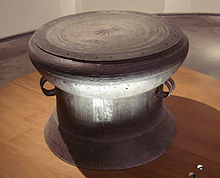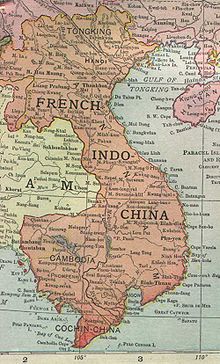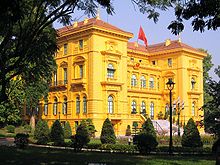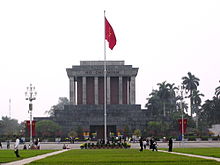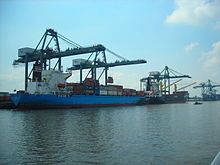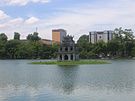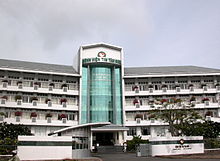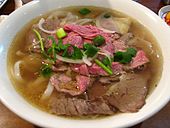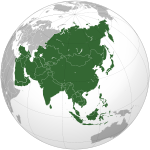- Vietnam
-
Socialist Republic of Vietnam Cộng hòa Xã hội chủ nghĩa Việt Nam

Flag Emblem Motto: Độc lập – Tự do – Hạnh phúc
"Independence – Freedom – Happiness"Anthem:
"Army March" (first verse)Location of Vietnam (green)in ASEAN (dark grey) — [Legend]
Capital Hanoi
21°2′N 105°51′E / 21.033°N 105.85°ELargest city Ho Chi Minh City Official language(s) Vietnamese Official scripts Vietnamese alphabet Demonym Vietnamese Government Unitary socialist republic,
Single-party state- President Trương Tấn Sang - Prime Minister Nguyễn Tấn Dũng - Chairman of National Assembly Nguyễn Sinh Hùng - Chief Justice Trương Hòa Bình - General Secretary of the CPV Nguyễn Phú Trọng Legislature National Assembly of Vietnam Formation - Independence from China 938 - Independence from France and Japan 2 September 1945 - Reunification 2 July 1976[1] - Current constitution 15 April 1992 Area - Total 331.698 km2 (65th)
128,565 sq mi- Water (%) 1.3 Population - 2011 estimate 90,549,390[2] (13th) - 2009 census 85,846,997[3] - Density 259/km2 (46th)
668/sq miGDP (PPP) 2010 estimate - Total $273.967 billion[4] - Per capita $3,104.179[4] GDP (nominal) 2010 estimate - Total $104.600 billion[5] - Per capita $1,168[4] Gini (2008) 38[6] (medium) HDI (2010)  0.572[7] (medium) (113th)
0.572[7] (medium) (113th)Currency đồng (₫)[8] ( VND)Time zone ICT (Indochina Time) UTC+7 (UTC+7) - Summer (DST) No DST (UTC+7) Drives on the right Internet TLD .vn Calling code 84 1 According to the official name and 1992 Constitution. Vietnam, sometimes spelled Viet Nam (
 i/ˌviːɛtˈnɑːm/ vee-et-nahm; Vietnamese: Việt Nam,
i/ˌviːɛtˈnɑːm/ vee-et-nahm; Vietnamese: Việt Nam,  listen), officially the Socialist Republic of Vietnam (Vietnamese: Cộng hòa xã hội chủ nghĩa Việt Nam,
listen), officially the Socialist Republic of Vietnam (Vietnamese: Cộng hòa xã hội chủ nghĩa Việt Nam,  listen), is the easternmost country on the Indochina Peninsula in Southeast Asia. It is bordered by China to the north, Laos to the northwest, Cambodia to the southwest, and the South China Sea – referred to in Vietnam as the East Sea (Vietnamese: Biển Đông) – to the east. With an estimated 90.5 million inhabitants as of 2011, Vietnam is the world's 13th-most-populous country, and the eighth-most-populous Asian country.
listen), is the easternmost country on the Indochina Peninsula in Southeast Asia. It is bordered by China to the north, Laos to the northwest, Cambodia to the southwest, and the South China Sea – referred to in Vietnam as the East Sea (Vietnamese: Biển Đông) – to the east. With an estimated 90.5 million inhabitants as of 2011, Vietnam is the world's 13th-most-populous country, and the eighth-most-populous Asian country.The Vietnamese became independent from Imperial China in 938 AD, following the Battle of Bạch Đằng River. Successive Vietnamese royal dynasties flourished as the nation expanded geographically and politically into Southeast Asia, until the Indochina Peninsula was colonized by the French in the mid-19th century. Efforts to resist the French eventually led to their expulsion from the country in the mid-20th century, leaving Vietnam divided politically into two countries. Fighting between the two sides continued, with heavy foreign intervention, during the Vietnam War, ending with a North Vietnamese victory in 1975.
Emerging from this prolonged military engagement, the war-ravaged Communist nation was politically isolated. In 1986, the government instituted economic and political reforms and began a path towards international reintegration.[9] By 2000, it had established diplomatic relations with most nations. Its economic growth has been among the highest in the world since 2000,[10] and according to Citigroup, such high growth is set to continue. Vietnam has the highest Global Growth Generators Index among 11 major economies,[11] and its successful economic reforms resulted in it joining the World Trade Organization in 2007. However, the country still suffers from high levels of income inequality,[dated info] disparities in healthcare provision, and poor gender equality.[12][13][14][15][16]
Etymology
Main article: Names of VietnamThe name Việt Nam (Vietnamese pronunciation: [vjə̀tnam]) is a variation of "Nam Việt" (南越; pinyin: Nányuè; literally Southern Việt), a name that can be traced back to the Trieu dynasty (2nd century BC).[17] The word "Việt" originated as a shortened form of Bách Việt (百越; pinyin: Bǎiyuè), a word applied to a group of peoples then living in southern China and Vietnam.[18] The form "Vietnam" (越南) is first recorded in the oracular poem Sấm Trạng Trình.[19] It has been found on 12 steles carved in the 16th and 17th centuries, including one at Bao Lam Pagoda in Haiphong that was carved in 1558.[20] Between 1804 and 1813, the name was used officially by Emperor Gia Long.[21] It was revived in the early 20th century by nationalists such as Phan Boi Chau, and most notably by the Viet Nam Quoc Dan Dang (Vietnamese Nationalist Party).[22] The country was usually called Annam until 1945, when Emperor Bao Dai changed the official name back to "Việt Nam".[22] Since the use of Chinese characters was discontinued at this time, the alphabetic spelling is official.
History
Main article: History of VietnamPre-Dynastic era
The area now known as Vietnam has been inhabited since Paleolithic times, with some archaeological sites in Thanh Hóa Province purportedly dating back several thousand years. Archaeologists link the beginnings of Vietnamese civilization to the late Neolithic-early Bronze Age Phung Nguyen culture, which was centered in what is now Vĩnh Phúc Province between 2000 and 1400 BC.
By about 1200 BC, the development of wet-rice cultivation and bronze casting in the Ma River and Red River plains led to the development of the Dong Son culture, notable for its elaborate bronze drums. The bronze weapons, tools, and drums of Dong-Sonian sites show a Southeast Asian influence that indicates an indigenous origin for the bronze-casting technology.
Many small, ancient copper mine sites have been found in northern Vietnam. Some of the similarities between the Dong-Sonian sites and other Southeast Asian sites include the presence of boat-shaped coffins and burial jars, stilt dwellings, and evidence of the customs of betel-nut-chewing and teeth-blackening.
Dynastic era
The legendary Hồng Bàng Dynasty of the Hùng kings is considered the first Vietnamese state, known in Vietnamese as Văn Lang. In 257 BC, the last Hùng king was defeated by Thục Phán, who consolidated the Lạc Việt tribes and Âu Việt tribes to form the Âu Lạc, proclaiming himself An Dương Vương. In 207 BC, a Chinese general named Zhao Tuo defeated An Dương Vương and consolidated Âu Lạc into Nanyue. However, Nanyue was itself incorporated into the empire of the Chinese Han Dynasty in 111 BC.
For the next thousand years, Vietnam remained mostly under Chinese rule.[23] Early independence movements, such as those of the Trưng Sisters and Lady Triệu, were only temporarily successful, but the region did become independent as Vạn Xuân under the Anterior Lý Dynasty between 544 and 602 AD. By the early 10th century, Vietnam had gained autonomy, but not independence, under the Khúc family.
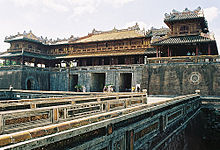 The Imperial City in Huế.
The Imperial City in Huế.
In 938 AD, a Vietnamese lord named Ngô Quyền defeated Chinese forces at Bạch Đằng River and regained independence after a millennium of Chinese domination.[24] Renamed as Đại Việt (en: Great Viet), the nation enjoyed a golden era under the Lý and Trần Dynasties. During the rule of the Trần Dynasty, Đại Việt repelled three Mongol invasions.[25] Buddhism flourished and became the state religion.
Following the brief Hồ Dynasty, Vietnamese independence was momentarily interrupted by the Chinese Ming Dynasty, but was restored by Lê Lợi, the founder of the Lê Dynasty. Vietnam reached its zenith in the Lê Dynasty of the 15th century, especially during the reign of Emperor Lê Thánh Tông (1460–1497). Between the 11th and 18th centuries, Vietnam expanded southward in a process known as nam tiến (southward expansion),[26] and it eventually conquered the kingdom of Champa and part of the Khmer Empire.[27][28]
From the 16th century onwards, civil strife and frequent infighting engulfed much of Vietnam. First, the Chinese-supported Mạc Dynasty challenged the Lê Dynasty's power. After the Mạc Dynasty was defeated, the Lê Dynasty was nominally reinstalled, but actual power was divided between the northern Trịnh Lords and the southern Nguyễn Lords, who engaged in a civil war for more than four decades before a truce was called in the 1670s. During this time, the Nguyễn expanded southern Vietnam into the Mekong Delta, annexing the Central Highlands and the Khmer land in the Mekong Delta.
The division of the country ended a century later when the Tây Sơn brothers defeated both and established their new dynasty. However, their rule did not last long, and they were defeated by the remnants of the Nguyễn Lords led by Nguyễn Ánh, with the help of the French.[citation needed] Nguyễn Ánh unified Vietnam, and established the Nguyễn Dynasty, ruling under the name Gia Long.
French colonisation
Vietnam's independence was gradually eroded by France—aided by large Catholic collaborator militias—in a series of military conquests from 1859 until 1885 when the entire country became part of French Indochina. The French administration imposed significant political and cultural changes on Vietnamese society. A Western-style system of modern education was developed, and Roman Catholicism was propagated widely in Vietnamese society. Most of the French settlers in Indochina were concentrated in Cochinchina (southern third of Vietnam whose principal city was Saigon).[29]
Developing a plantation economy to promote the exports of tobacco, indigo, tea and coffee, the French largely ignored increasing calls for self-government and civil rights. A nationalist political movement soon emerged, with leaders such as Phan Boi Chau, Phan Chu Trinh, Phan Dinh Phung, Emperor Hàm Nghi and Ho Chi Minh fighting or calling for independence. However, the royalist Can Vuong was defeated in the 1890s after a decade of resistance, and the 1930 Yen Bai mutiny of the Viet Nam Quoc Dan Dang was put down easily. The French maintained control of their colonies until World War II, when the Japanese war in the Pacific triggered the invasion of French Indochina in 1941.
With the defeat of France in Europe, the French Third Republic transformed into the Vichy Regime, to which the colony remained loyal. Heavily dependent on Nazi Germany, Vichy France was forced to surrender control of French Indochina to Japan. The natural resources of Vietnam were exploited for the purposes of the Japanese Empire's military campaigns into the British Indochinese colonies of Burma, the Malay Peninsula and India.
First Indochina War
Main articles: First Indochina War, Democratic Republic of Vietnam, State of Vietnam, State of Vietnam referendum, 1955, and Operation Passage to FreedomIn 1941, the Viet Minh – a communist and nationalist liberation movement – emerged under Ho Chi Minh to seek independence for Vietnam from France as well as to oppose the Japanese occupation. Japanese occupation during World War II caused the Vietnamese Famine of 1945, which caused 2 million deaths, or 10% of the population then.[30] Following the military defeat of Japan and the fall of its Empire of Vietnam in August 1945, Viet Minh occupied Hanoi and proclaimed a provisional government, which asserted independence on 2 September.[31]
In the same year the Provisional French Republic sent the French Far East Expeditionary Corps, which was originally created to fight the Japanese occupation forces, in order to pacify the liberation movement and to restore French rule. On November 20, 1946, triggered by the Haiphong Incident, the First Indochina War between Viet Minh and the French forces ensued, lasting until July 20, 1954.
Despite fewer losses – Expeditionary Corps suffered one-third of the casualties of the Chinese and Soviet-backed Viet Minh – during the course of the war, the French and Vietnamese loyalists eventually suffered a major strategic setback at the Siege of Dien Bien Phu, which allowed Ho Chi Minh to negotiate a ceasefire with a favorable position at the ongoing Geneva conference of 1954. Colonial administration ended as French Indochina was dissolved. According to the Geneva Accords of 1954 the forces of former French supporters and communist nationalists were separated south and north, respectively, with the Vietnamese Demilitarized Zone, at the 17th parallel north, between. A 300-day period of free movement was given, during which almost a million northerners, mainly Catholic, moved south, fearing persecution by the communists.
A partition of Vietnam, with Ho Chi Minh's Democratic Republic of Vietnam in North Vietnam, and Emperor Bảo Đại's State of Vietnam in the South Vietnam, was not intended to be permanent by the Geneva Accords, and they expressly forbade the interference of third powers. The State of Vietnam's Prime Minister Ngo Dinh Diem toppled Bảo Đại in a fraudulent referendum organised by his brother Ngo Dinh Nhu, and proclaimed himself president of the Republic of Vietnam. The Accords mandated nationwide elections by 1956, which Diem refused to hold, despite repeated calls from the North for talks to discuss elections.[32]
Vietnam War
Main articles: Vietnam War, North Vietnam, South Vietnam, Ngo Dinh Diem, Buddhist crisis, Role of the United States in the Vietnam War, ARVN, Viet Cong, Ho Chi Minh Trail, and Operation MenuThe pro-Hanoi Vietcong began a guerrilla campaign in the late 1950s to overthrow Diem's government, which an official Vietcong statement described as a "disguised colonial regime."[32] In the North, thousands of landowners were murdered by the communists and famine broke out in the 1950s. In the South, Diem went about crushing all opposition and tens of thousands were jailed or killed; dissidents were routinely labelled as communists even if they were anti-communist. Both Vietnams were police states with totalitarian security systems.
 A Viet Cong soldier stands guard during a prisoner exchange with American forces in 1973.
A Viet Cong soldier stands guard during a prisoner exchange with American forces in 1973.
In 1963, Buddhist discontent with Diem's pro-Catholic discrimination erupted following the banning of the Buddhist flag and the Hue Vesak shootings. This resulted in a series of mass demonstrations during what is known as the Buddhist crisis. With Diem unwilling to bend, Nhu orchestrated the Xa Loi Pagoda raids; estimates of the death toll range into the hundreds. As a result, America's relationship with Diem broke down and resulted in the 1963 coup that saw Diem killed.
Diem was followed by a series of military regimes that often lasted only months before being toppled by another. With this instability, the communists began to gain ground. There were more than a dozen governments before the pairing of Air Marshal Nguyen Cao Ky and General Nguyễn Văn Thiệu took control of a junta in mid-1965. Thieu gradually outmaneuvered Ky and cemented his grip on power in fraudulent elections in 1967 and 1971.[citation needed]
To support South Vietnam's struggle against the communist insurgency, the United States began increasing its contribution of military advisers. US forces became embroiled in ground combat operations in 1965 and at their peak they numbered more than 500,000.[33][34] Communist forces attacked most major targets in South Vietnam during the 1968 Tet Offensive, and although their campaign failed militarily, it shocked the American establishment, and caused them to think that the communists could not be defeated.[35] Communist forces supplying the Vietcong carried supplies along the Ho Chi Minh trail, which passed through Laos and Cambodia. US president Richard Nixon authorized Operation Menu, an SAC bombing campaign in Laos and Cambodia, which he kept secret from the US Congress.[36][37]
Its own casualties mounting, and facing opposition to the war at home and condemnation abroad, the U.S. began withdrawing from ground combat roles according to the Nixon Doctrine; the process was subsequently called Vietnamization. The effort had mixed results. The Paris Peace Accords of 27 January 1973 formally recognized the sovereignty of Vietnam "as recognized by the 1954 Geneva Agreements." Under the terms of the accords all American combat troops were withdrawn by 29 March 1973. Limited fighting continued, before the north captured the province of Phuoc Long in December 1974 and started a full-scale offensive, culminating in the Fall of Saigon on 30 April 1975. South Vietnam briefly came under the nominal rule of a Provisional Revolutionary Government while under military occupation by North Vietnam. On 2 July 1976, North and South were merged to form the Socialist Republic of Vietnam.[1]
Postwar period
The government embarked on a mass campaign of collectivization of farms and factories. This caused an economic collapse and resulted in triple-digit inflation. Reconstruction of the war-ravaged country was slow, and serious humanitarian and economic problems confronted the communist regime. Millions of people fled the country in crudely built boats, creating an international humanitarian crisis.[38][39]
In 1978, the Vietnamese army invaded Cambodia (sparking the Cambodian-Vietnamese War) to remove from power the Khmer Rouge—who had been razing Vietnamese border villages and massacring the inhabitants,[40] installing a regime whose leaders ruled until 1989.[41] This action worsened relations with China, which launched a brief incursion into northern Vietnam (the Sino-Vietnamese War) in 1979.[42] This conflict caused Vietnam to rely even more heavily on Soviet economic and military aid.
Đổi Mới ("Renovation")
At the Sixth Congress of the Communist Party of Vietnam in December 1986, reformers, upset by the lack of economic progress after the Vietnam War,[43] replaced the "old guard" with new leadership.[44] The reformers were led by 71 year-old Nguyen Van Linh, who became the party's new general secretary.[44] Linh was a native of northern Vietnam who had served in the south both during and after the war.[43][44] In a historic shift, the reformers implemented free-market reforms known as Đổi Mới (Renovation), which carefully managed the transition from a planned economy to a "socialist-oriented market economy".[45][46]
With the authority of the state remaining unchallenged, private ownership of farms and companies engaged in commodity production, deregulation and foreign investment were encouraged while the state maintained control over strategic industries.[46] The economy of Vietnam subsequently achieved rapid growth in agricultural and industrial production, construction and housing, exports and foreign investment. However, these reforms have also caused a rise in inequalities in many spheres of social life, such as income and gender inequality.[13][14][15][16]
Government and politics
Main articles: Politics of Vietnam and Military of VietnamThe Socialist Republic of Vietnam is a single-party state. Its current state constitution, which replaced the 1975 constitution in April 1992, asserts the central role of the Communist Party of Vietnam in all organs of government, politics and society. Only political organizations affiliated with or endorsed by the Communist Party are permitted to contest elections in Vietnam. These include the Vietnamese Fatherland Front and worker and trade unionist parties. Although the state remains officially committed to socialism as its defining creed, its economic policies are increasingly capitalist,[47] with the The Economist defining its leadership as "ardently capitalist communists".[48]
The President of Vietnam is the titular head of state and the nominal commander-in-chief of the military of Vietnam, serving as the Chairman of the Council of Supreme Defense and Security. The Prime Minister of Vietnam is the head of government, presiding over a council of ministers composed of three deputy prime ministers and the heads of 26 ministries and commissions.
The National Assembly of Vietnam is the unicameral legislature of the state, composed of 498 members. Headed by a Chairman, it is superior to both the executive and judicial branches, with all government ministers being appointed from members of the National Assembly. The Supreme People's Court of Vietnam is the country's highest court of appeal, headed by a Chief Justice, though it is also answerable to the National Assembly. Beneath the Supreme People's Court stand the provincial municipal courts and numerous local courts. Military courts possess special jurisdiction in matters of national security.
The General Secretary of the Communist Party performs numerous key administrative and executive functions, controlling the party's national organization and state appointments, as well as setting policy.
Military
The Vietnam People's Armed Forces consists of the Vietnam People's Army, the Vietnam People's Public Security and the Vietnam Civil Defense Force. The Vietnam People's Army (VPA) is the official name for the active military services of Vietnam, and is subdivided into the Vietnam People's Ground Forces, the Vietnam People's Navy, the Vietnam People's Air Force, the Vietnam Border Defense Force, the Vietnam Air Defense Force and the Vietnam Marine Police. The VPA has an active manpower of around 450,000, but its total strength, including paramilitary forces, may be as high as 5,000,000.[49]
Through Vietnam's recent history, the VPA has been actively involved in developing the economy of Vietnam, with detachments working in such areas as industry, agriculture, forestry, fishery and telecommunications. However, the role of the military in public life has steadily been reduced since the 1980s.[citation needed]
International relations
Main article: Foreign relations of VietnamVietnamese troops on Spratly Island.
Throughout its history, Vietnam's key foreign relationship has been with its northern neighbour, China. Vietnam's sovereign principles and insistence on cultural independence have been laid down in numerous documents over the centuries, such as the 11th-century poem Nam quốc sơn hà and the 1428 proclamation Bình Ngô đại cáo.
Currently, the formal mission statement of Vietnamese foreign policy is to: "Implement consistently the foreign policy line of independence, self-reliance, peace, cooperation and development; the foreign policy of openness and diversification and multi-lateralization of international relations. Proactively and actively engage in international economic integration while expanding international cooperation in other fields."[50] Vietnam furthermore declares itself to be "a friend and reliable partner of all countries in the international community, actively taking part in international and regional cooperation processes."[50]
As of December 2007, Vietnam had established diplomatic relations with 172 countries, including the United States, which normalized relations in 1995.[51][52] Vietnam holds membership of 63 international organizations, including the United Nations, ASEAN, NAM, Francophonie and WTO, and a total of 650 non-government organizations.[53]
Administrative subdivisions
Main articles: Provinces of Vietnam and Districts of VietnamVietnam is divided into 58 provinces (Vietnamese: as tỉnh, from the Chinese 省, shěng). There are also five centrally-controlled municipalities existing at the same level as provinces (thành phố trực thuộc trung ương).
A clickable map of Vietnam exhibiting its 58 provinces and 5 centrally controlled municipalities.

Bắc Ninh
Ha Nam
Ha Tay
Hai Duong
Hung Yen
Nam Dinh
Ninh Binh
Thai Binh
Vĩnh Phúc
Hanoi (municipality)
Hai Phong (municipality)
Ha Tinh
Nghe An
Quang Binh
Quảng Trị
Thanh Hóa
Thừa Thiên-Huế
Bắc Giang
Bắc Kạn
Cao Bang
Ha Giang
Lang Son
Lao Cai
Phu Tho
Quang Ninh
Thái Nguyên
Tuyen Quang
Yen Bai
Binh Dinh
Binh Thuan
Khanh Hoa
Ninh Thuan
Phu Yen
Quang Nam
Quang Ngai
Da Nang (municipality)
Ba Ria-Vung Tau
Binh Duong
Binh Phuoc
Dong Nai
Tay Ninh
Ho Chi Minh (municipality)
An Giang
Bạc Liêu
Bến Tre
Ca Mau
Dong Thap
Hau Giang
Kien Giang
Long An
Soc Trang
Tien Giang
Tra Vinh
Vĩnh Long
Cần Thơ (municipality)The provinces are subdivided into provincial municipalities (thành phố trực thuộc tỉnh), townships (thị xã) and counties (huyện), which are in turn subdivided into towns (thị trấn) or communes (xã). The centrally-controlled municipalities are subdivided into districts (quận) and counties, which are further subdivided into wards (phường).
Geography and climate
Main articles: Geography of Vietnam and Climate of VietnamVietnam is located on the eastern Indochina Peninsula between the latitudes 8° and 24°N, and the longitudes 102° and 110°E. It covers a total area of approximately 331,688 km2 (128,065 sq mi) in area, excluding the Hoang Sa and Truong Sa islands, making it almost the size of Germany. The combined length of the country's land boundaries is 4,639 km (2,883 mi), and its coastline is 3,444 km (2,140 mi) long. Vietnam's land is mostly hilly and densely forested, with level land covering no more than 20%. Mountains account for 40% of the country's land area, and tropical forests cover around 42%.
 Son Doong Cave, the world's largest cave, in Vietnam's Phong Nha-Ke Bang National Park.
Son Doong Cave, the world's largest cave, in Vietnam's Phong Nha-Ke Bang National Park.
The northern part of the country consists mostly of highlands and the Red River Delta. Phan Xi Păng, located in Lào Cai province, is the highest mountain in Vietnam, standing 3,143 m (10,312 ft) high. Southern Vietnam is divided into coastal lowlands, Annamite Chain peaks, and extensive forests. Comprising five relatively flat plateaus of basalt soil, the highlands account for 16% of the country's arable land and 22% of its total forested land. The soil in much of southern Vietnam is relatively poor in nutrients.
The Red River Delta (also known as the Sông Hồng), a flat, roughly triangular region covering 15,000 km2 (5,792 sq mi),[54] is smaller but more intensely developed and more densely populated than the Mekong River Delta. Once an inlet of the Gulf of Tonkin, it has been filled in over the millennia by riverine alluvial deposits, and it advances 100 meters (328.1 ft) into the Gulf annually. The Mekong delta, covering about 40,000 km2 (15,444 sq mi), is a low-level plain no more than 3 meters (9.8 ft) above sea level at any point. It is criss-crossed by a maze of rivers and canals, which carry so much sediment that the delta advances 60 to 80 meters (196.9 to 262.5 ft) into the sea every year.
Because of differences in latitude and the marked variety in topographical relief, the Vietnamese climate tends to vary considerably from place to place. During the winter or dry season, extending roughly from November to April, the monsoon winds usually blow from the northeast along the China coast and across the Gulf of Tonkin, picking up considerable moisture. Consequently, the winter season in most parts of the country is dry only by comparison with the rainy or summer season. The average annual temperature is generally higher in the plains than in the mountains, and higher in the south than in the north. Temperatures vary less in the southern plains around Ho Chi Minh City and the Mekong Delta, ranging between 21 and 28 °C (69.8 and 82.4 °F) over the course of a year. Seasonal variations in the mountains and plateaus and in the north are much more dramatic, with temperatures varying from 5 °C (41 °F) in December and January to 37 °C (98.6 °F) in July and August.
Ecology and biodiversity
Vietnam has two World Natural Heritage Sites – Ha Long Bay and Phong Nha-Ke Bang National Park – and six biosphere reserves, including Can Gio Mangrove Forest, Cat Tien, Cat Ba, Kien Giang, Red River Delta, and Western Nghe An.
The Saola, one of the world's rarest mammals, is native to Vietnam.
Vietnam lies in the Indomalaya ecozone. According to Chapter 1 of the 2005 National Environmental Present Condition Report, "Biodiversity Subject of Vietnam Environment Protection Agency,"[55] in terms of species diversity Vietnam is one of twenty-five countries considered to possess a uniquely high level of biodiversity, and is ranked 16th in biological diversity worldwide, having 16% of the world's species. 15,986 species of flora have been identified in the country, of which 10% are endemic, while Vietnam's fauna include 307 nematode species, 200 oligochaeta, 145 acarina, 113 springtails, 7,750 insects, 260 reptiles, 120 amphibians, 840 birds and 310 mammals, of which 100 birds and 78 mammals are endemic.[55]
Vietnam is furthermore home to 1,438 species of freshwater microalgae, constituting 9.6% of all microalgae species, as well as 794 aquatic invertebrates and 2,458 species of sea fish.[55] In recent years, 13 genera, 222 species, and 30 taxa of flora have been newly described in Vietnam.[55] Six new mammal species, including the saola, giant muntjac and Tonkin Snub-nosed Langur have also been discovered, along with one new bird species, Edwards's Pheasant.[citation needed]
In agricultural genetic diversity, Vietnam is one of the world's twelve original cultivar centers. The Vietnam National Cultivar Gene Bank is preserving 12,300 cultivars of 115 species.[55] The Vietnamese government spent US$49.07 million on the preservation of biodiversity in 2004 alone, and has established 126 conservation areas, including 28 national parks.[55]
Economy
Main article: Economy of VietnamVietnam has been, for much of its history, a predominantly agricultural civilization based on wet rice cultivation. However, the Vietnam War destroyed much of the country's agrarian economy, leading the post-war government to implement a planned economy to revitalise agriculture and industrialise the nation. The collectivization of farms, factories and economic capital was implemented, and millions of people were put to work in government programs. For a decade following the Vietnam War, Vietnam's economy was plagued with inefficiency and corruption in state programs, poor quality and underproduction, and restrictions on economic activity. It also suffered from the post-war trade embargo instituted by the United States and most of Europe. These problems were compounded by the erosion of the Soviet bloc, which included Vietnam's main trading partners, in the late 1980s.
In 1986, the Sixth Party Congress of Vietnam introduced free market economic reforms as part of a broad reform package called Đổi Mới (Renovation), resulting in a socialist-oriented market economy. Private ownership was encouraged in industries, commerce and agriculture.[56] Thanks largely to these reforms, Vietnam achieved around 8% annual GDP growth between 1990 to 1997, and the economy continued to grow at an annual rate of around 7% from 2000 to 2005, making Vietnam one of the world's fastest growing economies. Growth remained strong even in the face of the late-2000s global recession, holding at 6.8% in 2010, but Vietnam's year-on-year inflation rate hit 11.8% in December 2010, according to a GSO estimate. The Vietnamese dong was devalued three times in 2010 alone.[57]
Manufacturing, information technology and high-tech industries now form a large and fast-growing part of the national economy. Though Vietnam is a relative newcomer to the oil industry, it is currently the third-largest oil producer in Southeast Asia, with an output of 400,000 barrels per day (64,000 m3/d). Like its Chinese neighbours, Vietnam continues to make use of centrally-planned economic five-year plans.
Deep poverty, defined as the percentage of the population living on less than $1 per day, has declined significantly in Vietnam, and the relative poverty rate is now less than that of China, India, and the Philippines.[58] This decline in the poverty rate can be attributed to equitable economic policies aimed at improving living standards and preventing the rise of inequality; these policies have included egalitarian land distribution at the initial stages of Đổi Mới, investment in poorer remote areas, and subsidising of education and healthcare.[59]
In 2010, Vietnam's nominal GDP reached US$103.124 billion,[4] with a nominal GDP per capita of $1,168, according to the International Monetary Fund (IMF).[4] According to a December 2005 forecast by Goldman Sachs, the Vietnamese economy will become the world's 17th-largest by 2025, with an estimated nominal GDP of $436 billion and a GDP per capita of $4,357.[60] According to a 2008 forecast by PricewaterhouseCoopers, Vietnam may be the fastest-growing of the world's emerging economies by 2025, with a potential growth rate of almost 10% per annum in real dollar terms; by 2050, such a growth rate would make it 70% of the size of the economy of the United Kingdom, currently one of the world's largest economies.[61]
Trade
Since the early 2000s, Vietnam has applied sequenced trade liberalisation, a two-track approach opening some sectors of the economy to international markets while protecting others.[59][62] In July 2006, Vietnam updated its intellectual property legislation to comply with TRIPS, and it became a member of the WTO on January 11, 2007. Vietnam is now one of Asia's most open economies: two-way trade was valued at around 160% of GDP in 2006, more than twice the contemporary ratio for China and over four times the ratio for India.[63] Vietnam's chief trading partners include China, Japan, Australia, the ASEAN countries, the United States and Western Europe.
As a result of several land reform measures, Vietnam has become a major exporter of agricultural products. It is now the world's largest producer of cashew nuts, with a one-third global share; the largest producer of black pepper, accounting for one-third of the world's market; and the second-largest rice exporter in the world, after Thailand. Vietnam has the highest proportion of land use for permanent crops – 6.93% – of any nation in the Greater Mekong Subregion. Other primary exports include coffee, tea, rubber, and fishery products. However, agriculture's share of Vietnam's GDP has fallen in recent decades, declining from 42% in 1989 to 20% in 2006, as production in other sectors of the economy has risen. According to the CIA World Factbook, the unemployment rate in Vietnam stood at 2.9% in April 2009.[64]
Transport
Main article: Transport in VietnamVietnam's modern transport system was originally developed under French rule to facilitate the transportation of raw materials, and was reconstructed and extensively modernized following the Vietnam War.
Air
Main article: Air transport in Vietnam An aircraft sporting Vietnam Airlines livery.
An aircraft sporting Vietnam Airlines livery.
Vietnam operates 17 major civil airports, including three international gateways: Noi Bai serving Hanoi, Da Nang International Airport serving Da Nang, and Tan Son Nhat serving Ho Chi Minh City. Tan Son Nhat is the nation's largest airport, handling 75 percent of international passenger traffic. According to a state-approved plan, Vietnam will have 10 international airports by 2015 – besides the aforementioned three, these include Lien Khuong International Airport, Phu Bai International Airport, Cam Ranh International Airport, Phu Quoc International Airport, Cat Bi International Airport, Cần Thơ International Airport and Long Thanh International Airport. The planned Long Thanh International Airport will be built on an area of 50 square kilometres (19 sq mi), and will have full capacity of 100 million passengers.
Vietnam Airlines, the state-owned national airline, maintains a fleet of 69 passenger aircraft,[65][66] and aims to operate 150 by 2020. Several private airlines are also in operation in Vietnam, including Air Mekong, Jetstar Pacific Airlines and VASCO.
Road
A bus in Ho Chi Minh City.
Vietnam's road system includes national roads administered at the central level; provincial roads managed at the provincial level; district roads managed at the district level; urban roads managed by cities and towns; and commune roads managed at the commune level. Bicycles, motor scooters and motorcycles remain the most popular forms of road transport in Vietnam's urban areas, although the number of privately-owned automobiles is also on the rise, especially in the larger cities. Public buses operated by private companies are the main mode of long-distance travel for much of the population.
Road safety is a serious issue in Vietnam – on average, 30 people are killed in traffic accidents every day.[67] Traffic congestion is a growing problem in Hanoi and Ho Chi Minh City, as the cities' roads struggle to cope with the boom in automobile use.
Rail
Main article: Rail transport in VietnamCurrently, Vietnam's primary cross-country rail service is the Reunification Express, which runs from Ho Chi Minh City to Hanoi, covering a distance of nearly 2,000 kilometres. From Hanoi, railway lines branch out to the northeast, north and west;the eastbound line runs from Hanoi to Ha Long Bay, the northbound line runs from Hanoi to Thai Nguyen and the northeast line runs from Hanoi to Lao Cai.
In 2009, Vietnam and Japan signed a deal to build a high-speed railway using Japanese technology; numerous Vietnamese engineers have since been sent to Japan to receive training in the operation and maintenance of high-speed trains. The railway will be a 1,630-km-long[68] express route, serving a total of 26 stations, including Hanoi and the Thu Thiem terminus in Ho Chi Minh City.[69]
Using Japan's well-established Shinkansen technology,[70] the line will support trains travelling at a maximum speed of 360 kilometres (220 mi) per hour. The high-speed lines linking Hanoi to central Vinh and central Nha Trang to Ho Chi Minh City in southern Vietnam will be laid during the 2010–2015 period. From 2015 to 2020, construction will begin on the routes between Vinh and Nha Trang and between Hanoi and the northern provinces of Lao Cai and Lang Son.
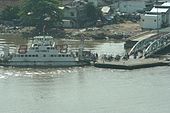 A ferry crossing the Saigon River.
A ferry crossing the Saigon River.
Water
Vietnam has several major sea ports, including Cam Ranh, Da Nang, Hai Phong, Ho Chi Minh City, Hong Gai, Qui Nhơn, and Nha Trang. Further inland, the country's extensive network of rivers play a key role in rural transportation, with over 17,000 kilometres (11,000 mi) of navigable waterways.
Demographics
 Cham people dancing at a temple in Nha Trang, southern Vietnam.
Cham people dancing at a temple in Nha Trang, southern Vietnam. Main article: Demographics of Vietnam
Main article: Demographics of VietnamPopulation
Main articles: Vietnamese people and Ethnic groups in VietnamThe census of April 1, 2009, recorded the population of Vietnam as standing at approximately 85.8 million, of which the Viet or Kinh ethnic group constituted nearly 73.6 million, or 85.8% of the population. Census results of October 1979 showed the total population of reunified Vietnam to be 52.7 million.[71] The Kinh population is concentrated mainly in the alluvial deltas and coastal plains of the country. A largely homogeneous social and ethnic group, the Kinh possess significant political and economic influence over the country as its ethnic majority. Vietnam is furthermore home to 54 ethnic minority groups, including the Hmong, Dao, Tay, Thai, and Nung.
Many ethnic minorities – such as the Muong, who are closely related to the Kinh – dwell in the highlands, which cover two-thirds of Vietnam's territory. Before the Vietnam War, the population of the Central Highlands was almost exclusively Degar (including over 40 tribal groups); however, Ngo Dinh Diem's governments enacted a program of resettling Kinh in indigenous areas.[citation needed] The Hoa (ethnic Chinese)[72] and Khmer Krom are mainly lowlanders. As Sino-Vietnamese relations soured in 1978 and 1979, some 450,000 Hoa left Vietnam.[73]
Largest cities
Largest cities of Vietnam
2009 CensusRank City Name Province Pop. 
Hồ Chí Minh City
1 Hồ Chí Minh City Hồ Chí Minh City 7,162,864 
Hải Phòng
2 Hà Nội Hà Nội 6,448,837 3 Hải Phòng Hải Phòng 1,837,302 4 Cần Thơ Cần Thơ 1,187,089 5 Đà Nẵng Đà Nẵng 887,069 6 Biên Hòa Đồng Nai 784,398 7 Nha Trang Khánh Hòa 392,279 8 Buôn Ma Thuột Đắk Lắk 340,000 9 Huế Thừa Thiên-Huế 333,715 10 Thái Nguyên Thái Nguyên 330,000 Languages
Main article: Vietnamese language A Vietnamese vocabulary table. The words in orange belong to the native Vietnamese vocabulary, while the ones in green belong to the Sino-Vietnamese vocabulary.
A Vietnamese vocabulary table. The words in orange belong to the native Vietnamese vocabulary, while the ones in green belong to the Sino-Vietnamese vocabulary.
The official national language of Vietnam is Vietnamese, a tonal monosyllabic Mon–Khmer language which is spoken by the majority of the population. In its early history, Vietnamese writing used Chinese characters. In the 13th century, the Vietnamese developed their own set of characters, referred to as Chữ nôm. The folk epic Đoạn trường tân thanh (Truyện Kiều or The Tale of Kieu) by Nguyễn Du was written in Chữ nôm. Quốc ngữ, the romanized Vietnamese alphabet used for spoken Vietnamese, was developed in 17th century by the Jesuit Alexandre De Rhodes and several other Catholic missionaries. Quốc ngữ became widely popular and brought literacy to the Vietnamese masses during the French colonial period.
Various other languages are spoken by Vietnam's minority groups. The most common of these include Tày, Mường, Cham, Khmer, Chinese, Nùng, and H'Mông. The Montagnard peoples of the Central Highlands also speak a number of distinct languages.
The French language, a legacy of colonial rule, is still spoken by some older Vietnamese as a second language, but is losing its popularity. Vietnam nevertheless remains a full member of the Francophonie. Russian – and to a much lesser extent German, Czech and Polish – are known among some Vietnamese whose families had ties with the Soviet bloc during the Cold War. In recent years, English is becoming more popular as a second language; the study of English is now obligatory in most schools. Chinese and Japanese have also grown in popularity as Vietnam's links with China and Japan have strengthened.
Religion
Main article: Religion in VietnamFor much of Vietnamese history, Mahayana Buddhism, Taoism and Confucianism have been the dominant religions, strongly influencing the national culture. About 85% of Vietnamese identify with Buddhism, though not all practice on a regular basis.[74][75][76][77][78][79][80] Most people ascribe to Tam Đạo ("Triple religion"): 80% of people worship the mixture of Mahayana Buddhism mainly, Taoism, Confucianism with Ancestor Worship; 2% Hòa Hảo (a new 20th century religious movement that is concentrated in the Mekong Delta) and 2% Theravada Buddhism, mainly among Khmer people in the Mekong. According to the 2009 census, while over 10 million people have taken refuge in the Three Jewels,[81][82] the vast majority of Vietnamese people practice ancestor worship in some form.
About 8% of the population are Christians, totalling around six million Roman Catholics and fewer than one million Protestants, according to the census of 2007. Christianity was first introduced to Vietnam by Portuguese and Dutch traders in the 16th and 17th centuries, and was further propagated by French missionaries in the 19th and 20th centuries, and to a lesser extent, by American Protestant missionaries during the Vietnam War, largely among the Montagnards of South Vietnam. The largest Protestant churches are the Evangelical Church of Vietnam and the Montagnard Evangelical Church. Two-thirds of Vietnam's Protestants are reportedly members of ethnic minorities.[83]
The Vietnamese government is widely seen as suspicious of Roman Catholicism. This mistrust originated during the 19th century, when some Catholics collaborated with the French colonists in conquering and ruling the country and in helping French attempts to install Catholic emperors, such as in the Lê Văn Khôi revolt of 1833. Furthermore, the Catholic Church's strongly anti-communist stance has made it an enemy of the Vietnamese state. The Vatican Church is officially banned and only government-controlled Catholic organisations are permitted. However, Vietnam's relations with the Vatican have improved in recent years.
Several other minority faiths exist in Vietnam. About 3% of the population are adherents of Cao Dai, a syncretic modern religion that is concentrated around Tay Ninh Province. Sunni and Cham Bani Islam is primarily practiced by the ethnic Cham minority, though there are also a few ethnic Vietnamese adherents in the southwest. In total, there are approximately 70,000 Muslims in Vietnam,[84] while around 50,000 Hindus and a small number of Baha'is are also in evidence.
The Vietnamese government rejects allegations that it does not allow religious freedom. The state's official position on religion is that all citizens are free to their belief, religion and that all regions are equal before law.[85] Nevertheless, only government-controlled religious organisations are allowed, and the South Vietnam-founded Unified Buddhist Congregation of Vietnam is banned in favour of a communist-approved body.[citation needed]
Education
Main article: Education in Vietnam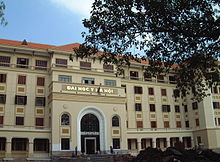 The University of Medicine in Hanoi.
The University of Medicine in Hanoi.
Vietnam has an extensive state-controlled network of schools, colleges and universities, and a growing number of privately-run and partially-privatised institutions. General education in Vietnam is divided into five categories: kindergarten, elementary schools, middle schools, high schools, anduniversities. A large number of public schools have been organized across the country to raise the national literacy rate, which stood at 90.3% in 2008.[86] There are a large number of specialist colleges, established to develop a more diverse and skilled national workforce.
A large number of Vietnam's most acclaimed universities are based in Hanoi and Ho Chi Minh City. Facing serious crises, Vietnam's education system is under a holistic program of reform launched by the government. Education is not free; therefore, some poor families may have trouble paying tuition for their children without some form of public or private assistance. Regardless, school enrollment is among the highest in the world, and the number of colleges and universities increased dramatically in the 2000s, from 178 in 2000 to 299 in 2005.
Health
Main article: Health in VietnamTam Duc-Hospital in Ho Chi Minh City.
Public health in Vietnam is of a reasonably high standard. As of 2009, the national life expectancy is 76 years for women and 72 for men,[87] and infant mortality stands at 12 per 1,000 live births.[88] As of 2009, 85% of the population has access to improved water sources.[87] However, malnutrition is still common in the rural provinces.[citation needed] In 2001, government spending on health care corresponded to just 0.9% of Vietnam's gross domestic product (GDP), with state subsidies covering only about 20% of health care expenses.[89]
In 1954, North Vietnam established a public health system that reached down to the hamlet level.[citation needed] After the national reunification in 1975, this system was extended to the provinces of former South Vietnam.[citation needed] In the late 1980s, the quality of healthcare declined to some degree as a result of budgetary constraints, a shift of responsibility to the provinces, and the introduction of charges. Inadequate funding has also contributed to a shortage of nurses, midwives, and hospital beds; in 2000, Vietnam had only 250,000 hospital beds, or 14.8 beds per 10,000 people, according to the World Bank.[89]
Since the early 2000s, Vietnam has made significant progress in combating malaria, with the malaria mortality rate falling to about 5% of its 1990s equivalent by 2005, after the country introduced improved antimalarial drugs and treatment. However, tuberculosis cases are on the rise, with 57 deaths per day reported in May 2004. With an intensified vaccination program, better hygiene, and foreign assistance, Vietnam hopes to reduce sharply the number of TB cases and annual new TB infections.[89]
As of September 2005, Vietnam had diagnosed 101,291 HIV cases, of which 16,528 progressed to AIDS, and 9,554 died. However, the actual number of HIV-positive individuals is estimated to be much higher. An average, 40–50 new infections are reported every day in Vietnam. As of 2007, 0.5% of the population is infected with HIV, and this figure has remained stable since 2005.[90] In June 2004, the United States announced that Vietnam would be one of 15 nations to receive funding as part of a US$15 billion global AIDS relief plan.[89]
Science and technology
Historically, Vietnamese scholars did not practice "science" in its generally accepted meaning, but nonetheless developed many academic fields, especially social sciences and the humanities. Vietnamese scholarship has left a millennium-deep legacy of analytical writings, such as the Đại Việt sử ký toàn thư of Ngô Sĩ Liên. Vietnamese monks led by the abdicated Emperor Tran Nhan Tong developed the Trúc Lâm Zen branch of philosophy in the 13th century. Arithmetics and geometry have been widely taught in Vietnam since the 15th century, using the textbook Đại thành toán pháp by Lương Thế Vinh as a basis. Lương Thế Vinh introduced the notion of zero, while Mạc Hiển Tích used the term số ẩn (en: "unknown/secret/hidden number") to refer to negative numbers even earlier. Vietnamese scholars furthermore produced numerous encyclopedias, such as Lê Quý Đôn's Vân đài loại ngữ.
In recent times, Vietnamese scientists have made many significant contributions in various fields of study, most notably in mathematics. Hoàng Tụy pioneered the applied mathematics field of global optimization, while Ngô Bảo Châu won the 2010 Fields Medal for his proof of fundamental lemma in the theory of automorphic forms.
Media
Main article: Media of VietnamVietnam's media sector is regulated by the government in accordance with the 2004 Law on Publication.[92] It is generally perceived that Vietnam's media sector is controlled by the government to follow the official communist party line, though some newspapers are relatively outspoken.[93] The Voice of Vietnam is the official state-run national radio broadcasting service, broadcasting internationally via shortwave using rented transmitters in other countries, and providing broadcasts from its website. Vietnam Television is the national television broadcasting company. As Vietnam moved toward a free-market economy under its Đổi Mới reform program, the government's reliance on the print media to keep the public informed about its policies led to a near-doubling in the number of newspapers and magazines in the late 1990s and early 2000s.[citation needed]
Vietnam extensively regulates public Internet access, using both legal and technical means. The collaborative project OpenNet Initiative classifies Vietnam's level of online political censorship to be "pervasive"[94], while Reporters without Borders considers Vietnam to be one of 15 global "internet enemies".[95] While the government of Vietnam claims to safeguard the country against obscene or sexually-explicit content through its blocking efforts, many politically and religiously sensitive sites are also banned.[96]
Culture
Main article: Culture of Vietnam Municipal Theatre, also known as the Saigon Opera House
Municipal Theatre, also known as the Saigon Opera House
Vietnam is an agricultural civilization based on wet rice cultivation with ancient Dong Son culture as one of its defining aspects. The major stimulation of Vietnamese culture's development comes from indigenous factors. Vietnamese totems are Vietnamese dragon which is derived from crocodile and snake (Vietnam's National Father- Lạc Long Quân is a holy dragon), lạc- a holy bird (Vietnam's National Mother- Âu Cơ is a bird fairy), turtle and nghê- in dog's image. Vietnamese social is structured from units named làng (English: villages), not from lines of blood. Regarding national solidarity, all Vietnamese have a common ancestor death anniversary on the 10th day of the 3rd Lunar month (see Giỗ Tổ Hùng Vương).
Vietnam's culture is a part of Sinosphere that Confucianism and Laoism set the frameworks for Vietnam's feudal political systems and philosophy (Specifically, Vietnamese are closely related to Cantonese, Hakka, Hokkien and Hainan cultures. Many of these people have also immigrated into Vietnam). Moreover, Vietnam was partially indianized for some certain periods of time, mostly by Buddism. Through history, Cham culture, Cambodian culture, the culture of Tai people and other minority ethnic groups in Vietnam have been integrated with Vietnamese culture in correlated effects. Vietnam's contemporary culture is also influenced by Western culture, for example, American, French and Russian cultures.
The official spoken and written language of Vietnam is Vietnamese, currently written in Latin alphabet. However, according to many recent researches, Vietnam is believed to have had established a distinctive culture before the invasion of China's dynasties, including a syllabic writing system named Khoa Đẩu for Vietnamese language along with its education system nationwide.
In the socialist era, the cultural life of Vietnam has been deeply influenced by government-controlled media and the cultural influences of socialist programs. For many decades, foreign cultural influences were shunned and emphasis placed on appreciating and sharing the culture of communist nations such as the Soviet Union, China, Cuba and others. Since the 1990s, Vietnam has seen a greater exposure to Southeast Asian, European and American culture and media.
Clothing
 A Vietnamese woman wearing an Áo Dài
A Vietnamese woman wearing an Áo Dài
One of the most popular Vietnamese traditional garments is the "Áo Dài", worn often for special occasions such as weddings or festivals. White Áo dài is the required uniform for girls in many high schools across Vietnam. Áo Dài was once worn by both genders but today it is worn mainly by females, except for certain important traditional culture-related occasions where some men do wear it.
Cuisine
Main article: Vietnamese cuisineVietnamese cuisine uses very little oil and many vegetables. The main dishes are often based on rice, soy sauce, and fish sauce. Its characteristic flavors are sweet (sugar), spicy (serrano peppers), sour (lime), nuoc mam (fish sauce), and flavored by a variety of mint and basil.
Music
Vietnamese music varies slightly in the three regions: Bắc or North, Trung or Central, and Nam or South. Northern classical music is Vietnam's oldest and is traditionally more formal. Vietnamese classical music can be traced to the Mongol invasions, when the Vietnamese captured a Chinese opera troupe. Central classical music shows the influences of Champa culture with its melancholic melodies.
Literature
Vietnamese literature has a long history. Folk literature has been developed for centuries with many great arts, including a typical 6–8 verse poem kind named "ca dao", a system of tales about village establishers and heroes which served as cultural base for many cultural regions (for example, "Saint Gióng tales"). Written literatures dates from Ngô Dynasty with some admirable artists like Nguyễn Trãi with "Bình Ngô đại cáo", Trần Hưng Đạo with "Hịch tướng sĩ", Nguyễn Du with "Truyện Kiều" (English: The Tale of Kieu) and Nguyễn Đình Chiểu with "Lục Vân Tiên". Some genres play an important role in performance like "hát nói" in ca trù. Some poet unions have been formed like "Tao Đàn." The mordenization of literature has happened since Western cultural effect began in 19th century. The first transformation movement was "Thơ Mới" from 1932 to 1945.
Arts and sports
Vovinam and Bình Ðịnh martial arts are two popular Vietnamese martial arts practiced by many within Vietnam. Football (soccer) is the most popular team sport in Vietnam. Sports and games such as badminton, tennis, ping pong, and chess are also popular with large segments of the population. Volleyball, especially women's volleyball, is watched by a fairly large number of Vietnamese people. The (expatriate Vietnamese) community forms a prominent part of Vietnamese cultural life, introducing Western sports, films, music and other cultural activities in the nation.
Festivals
See also: List of festivals in VietnamVietnam has a plethora of festivals, the most important being the New Year Tết. The dates of the calendar are set by the Lunar Calendar.
Among countless other traditional Vietnamese occasions, the traditional Vietnamese wedding is very popular. Many of the age-old customs in a Vietnamese wedding continue to be celebrated by both Vietnamese in Vietnam and overseas, often combining both western and eastern elements.
Tourism
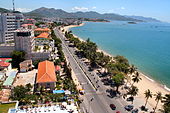 Nha Trang´s coastline
Nha Trang´s coastline
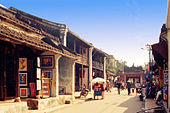 Hoi An, a UNESCO World Heritage Site
Hoi An, a UNESCO World Heritage Site
Vietnam's number of visitors for tourism and vacation has increased steadily over the past ten years. About 3.77 million international guests visited Vietnam in 2009.[97] The government and private enterprizes are investing capital into the coastal regions that are already popular for their beaches and boat tours.[98]
Popular destinations include Hanoi, Saigon, the old imperial capital of Hue, World Heritage Sites of Hoi An and the Cham temples of Mỹ Sơn, the coastline such as Nha Trang, the caves of Halong Bay, Marble Mountains, and many other sites. As tourism increases in importance, new projects are invested into, such as the tourism complex in Binh Duong, with the largest artificial sea in Southeast Asia.[99]
On Valentine's Day 2011 Joe Jackson, the father of popstar Michael Jackson, attended a ground breaking ceremony for what will be the region's largest entertainment complex, a five-star hotel and amusement park called "Happyland" in which he has investment interests. The $2 billion project, which has been designed to accommodate 14 million tourists annually, is located in southern Long An province about 20 minutes from Ho Chi Minh City. It is expected that the project will be finished in 2014.[100]
See also
- Outline of Vietnam
- Index of Vietnam-related articles
- CIVETS
References
- ^ a b Robbers, Gerhard (2007-01-30). Encyclopedia of world constitutions. Infobase Publishing. p. 1021. ISBN 9780816060788. http://books.google.com/books?id=M3A-xgf1yM4C&pg=PA1021. Retrieved 1 July 2011.
- ^ CIA – The World Factbook
- ^ General Statistics Office of Vietnam
- ^ a b c d e "Vietnam". International Monetary Fund. http://www.imf.org/external/pubs/ft/weo/2010/01/weodata/weorept.aspx?sy=2007&ey=2010&scsm=1&ssd=1&sort=country&ds=.&br=1&c=582&s=NGDPD%2CNGDPDPC%2CPPPGDP%2CPPPPC%2CLP&grp=0&a=&pr.x=71&pr.y=7. Retrieved 2010-04-21.
- ^ "GDP năm 2010 của Việt Nam vượt 100 tỷ USD". Vnexpress.net. 2010-12-29. http://vnexpress.net/GL/Kinh-doanh/2010/12/3BA24D1C/. Retrieved 2011-08-06.
- ^ "Gini Index". World Bank. http://data.worldbank.org/indicator/SI.POV.GINI/. Retrieved 2 March 2011.
- ^ "Human Development Report 2010. Human development index trends: Table G". The United Nations. http://hdr.undp.org/en/media/HDR_2010_EN_Table1.pdf. Retrieved 2011-01-05.
- ^ "Socialist Republic of Vietnam". Travelsradiate.com. http://www.travelsradiate.com/asia/socialist-republic-of-vietnam.html. Retrieved 2011-08-06.
- ^ "Vietnam's new-look economy". BBC News. 2004-10-18. http://news.bbc.co.uk/2/hi/asia-pacific/3752682.stm.
- ^ Vietnam's new-look economy 18.Oct.2004 bbc.co.uk
- ^ Joe Weisenthal (2011-02-22). "3G Countries". Businessinsider.com. http://www.businessinsider.com/willem-buiter-3g-countries-2011-2?slop=1. Retrieved 2011-08-06.
- ^ "Powered by Google Docs". Docs.google.com. http://docs.google.com/viewer?a=v&q=cache:p9Z51SI5fcYJ:www.spp.nus.edu.sg/Handler.ashx%3Fpath%3DData/Site/SiteDocuments/fritzen-brassard-inequality.pdf+rising+inequality+vietnam&hl=en&gl=uk&pid=bl&srcid=ADGEESj2eOA5fm7hoZPt6tC6FOOMka9Np3PR5W67LSBF5maIq4wwqqgAEKNq5T2ZFWC2whtg6V7y6cg6d1KjYRwhm558aq3HPf10UGtX_vZmuxD0FjGpJHaqCOIP5OV7ls8xbZxNRgiT&sig=AHIEtbSyYX0cq6MEvTfqlbh3Y2o_QmNjXQ. Retrieved 2010-11-07.
- ^ a b "Exploring income inequality in rural, coastal Viet Nam. – Journal of Development Studies". Highbeam.com. 1999-06-01. http://www.highbeam.com/doc/1G1-55397564.html. Retrieved 2010-11-07.
- ^ a b "ScienceDirect – Journal of Econometrics : On decomposing the causes of health sector inequalities with an application to malnutrition inequalities in Vietnam". Sciencedirect.com. 2002-09-12. http://www.sciencedirect.com/science?_ob=ArticleURL&_udi=B6VC0-46RKR42-2&_user=10&_coverDate=01%2F31%2F2003&_rdoc=1&_fmt=high&_orig=search&_origin=search&_sort=d&_docanchor=&view=c&_searchStrId=1459611705&_rerunOrigin=google&_acct=C000050221&_version=1&_urlVersion=0&_userid=10&md5=b695d65d3560f916f5fa8df6bc6b4c61&searchtype=a. Retrieved 2011-08-06.
- ^ a b Goodkind, D. (1995). "Rising Gender Inequality in Vietnam Since Reunification". Pacific Affairs 68 (3): 342–359. doi:10.2307/2761129.
- ^ a b Gallup, John Luke. "The wage labor market and inequality in Viet Nam in the 1990s". Ideas.repec.org. http://ideas.repec.org/p/wbk/wbrwps/2896.html. Retrieved 2010-11-07.
- ^ L. Shelton Woods (2002). Vietnam: a global studies handbook. ABC-CLIO. p. 38. ISBN 1576074161.
- ^ Yue-Hashimoto, Oi-kan (1972). Phonology of Cantonese. Cambridge University Press. pp. 1. ISBN 9780521084420. http://books.google.com/books?id=WY48AAAAIAAJ&dq=. "As a term referring to peoples, Yue is an abbreviation of Bai-Yue (百越 or 百粵, literally hundred Yue's)."
- ^ Nguyễn Bỉnh Khiêm, "Sấm Trạng Trình"
- ^ Thành Lân, "Ai đặt quốc hiệu Việt Nam đầu tiên?",Báo Đại đoàn kết, March 14, 2003.
- ^ At first, Gia Long requested the name Nam Việt, but Qing Emperor Jiaqing refused. L. Shelton Woods (2002). Vietnam: a global studies handbook. ABC-CLIO. p. 38. ISBN 1576074161.
- ^ a b Stein Tonnesson, Hans Antlov, Asian Forms of the Nation, Routledge, 1996, pp. 117.
- ^ "Chinese Colonization (200BC – 938AD)". Asia.msu.edu. Archived from the original on August 25, 2007. http://web.archive.org/web/20070825192025/http://www.asia.msu.edu/seasia/Vietnam/History/chinesecolonization.html. Retrieved 2010-04-28.
- ^ "Spears offer insight into early military strategy". January 22, 2006. Archived from the original on March 4, 2009. http://web.archive.org/web/20090304011202/http://vietnamnews.vnagency.com.vn/showarticle.php?num=04SUN220106.
- ^ "The Trần Dynasty and the Defeat of the Mongols". Countrystudies.us. http://countrystudies.us/vietnam/9.htm. Retrieved 2010-04-28.
- ^ "The Lê Dynasty and Southward Expansion". Countrystudies.us. http://countrystudies.us/vietnam/11.htm. Retrieved 2010-04-28.
- ^ authorName. "The Kingdom of Champa". Ancientworlds.net. http://www.ancientworlds.net/aw/Article/549713. Retrieved 2010-04-28.
- ^ "The Chams: Survivors of a Lost Civilisation". Cpamedia.com. http://www.cpamedia.com/history/cham_survivors/. Retrieved 2010-04-28.
- ^ French Counterrevolutionary Struggles: Indochina and Algeria. (PDF). United States Military Academy.
- ^ "Vietnam needs to remember famine of 1945". Mailman.anu.edu.au. http://mailman.anu.edu.au/pipermail/hepr-vn/2008-August/000188.html. Retrieved 2010-04-28.
- ^ Declaration of Independence, Democratic Republic of Vietnam – Vietnam Documents
- ^ a b The United States in Vietnam – An Analysis in Depth of America's Involvement in Vietnam, by George McTurnin Kahin and John W. Lewis Delta Books, 1967
- ^ "Vietnam War". Seasite.niu.edu. http://www.seasite.niu.edu/crossroads/cneher/cn.vietnamwar.htm. Retrieved 2010-04-28.
- ^ The War's Costs. Digital History.
- ^ Tet Offensive"...NLF/NVA troops and commandos attacked virtually every major town and city in South Vietnam as well as most of the important American bases and airfields...In Saigon, nineteen VC commandos blew their way through the outer walls of the US Embassy..."
- ^ Bombs over Cambodia Yale. Access 20 Nov '08
- ^ Operation Menu Access 20 Nov '08
- ^ United Nations High Commissioner for Refugees. "The State of The World's Refugees 2000 – Chapter 4: Flight from Indochina". http://www.unhcr.org/publ/PUBL/3ebf9bad0.pdf. Retrieved 2007-04-06.: Three million fled Vietnam, Cambodia, and Laos combined; close to a million Vietnamese were helped by the UNHCR.
- ^ Canadian Broadcasting Corporation. "Boat people: A Refugee Crisis". CBC News. http://archives.cbc.ca/IDD-1-69-524/life_society/boat_people/. Retrieved 2007-04-06.
- ^ Cambodia – The Fall of Democratic Kampuchea, U.S. Library of Congress
- ^ "Photographer Showcases Legendary Khmer Temple Preah Vihear". National Geographic. 23 June 2009. http://blogs.nationalgeographic.com/blogs/news/chiefeditor/2009/06/preah-vihear.html. Retrieved 12 July 2010.
- ^ Chinese Invasion of Vietnam, GlobalSecurity.org
- ^ a b Stowe, Judy (28 April 1998) "Obituary: Nguyen Van Linh" The Independent London, page 20
- ^ a b c Ackland, Len (20 March 1988) "Long after U.S. war, Vietnam is still a mess" St. Petersburg Times St. Petersburg, Florida, page 2-D
- ^ Murray, Geoffrey (1997) Vietnam: Dawn of a New Market St. Martin's Press, New York, pages 24–25, ISBN 0-312-17392-X
- ^ a b Hoang Thi Bich Loan (April 18, 2007). "Consistently pursuing the socialist orientation in developing the market economy in Vietnam". Communist Review, Tạp chí Cộng sản. Archived from the original on May 10, 2011. http://web.archive.org/web/20110510005305/http://www.tapchicongsan.org.vn/details_e.asp?Object=29152838&News_ID=18459436.
- ^ Kay Johnson (22 February 2007). "The Spoils of Capitalism". Time magazine. http://www.time.com/time/magazine/article/0,9171,1592581,00.html. Retrieved 19 May 2010.
- ^ "A bit of everything: Vietnam's quest for role models". The Economist. 24 April 2008. http://www.economist.com/specialreports/displaystory.cfm?story_id=E1_TTDQTVQR. Retrieved 19 May 2010. (subscription required)
- ^ International Institute for Strategic Studies; Hackett, James (ed.) (2010-02-03). The Military Balance 2010. London: Routledge. ISBN 1857435575.
- ^ a b "Vietnam Foreign Policy". http://www.mofa.gov.vn/en/cs_doingoai/. Retrieved 2009-02-25.
- ^ "List of countries which maintains diplomatic relations with the Socialist Republic of Vietnam (as of December 2007)". http://www.mofa.gov.vn/en/cn_vakv. Retrieved 2009-02-25.
- ^ "US-Vietnamese Relations". http://vietnam.usembassy.gov/relations.html. Retrieved 2009-12-08.
- ^ "Vietnam and International Organizations". http://www.mofa.gov.vn/en/ctc_quocte. Retrieved 2009-02-25.
- ^ "Agricultural advanced technologies in Red river delta, Viet Nam these days". Agroviet Newsletter. September 2005. Archived from the original on February 21, 2008. http://web.archive.org/web/20080221184058/http://xttm.agroviet.gov.vn/en/newsletter/2005/September.asp.
- ^ a b c d e f "Báo cáo Hiện trạng môi trường quốc gia 2005" (in Vietnamese). Archived from the original on February 23, 2009. http://web.archive.org/web/20090223065322/http://www.nea.gov.vn/HTMT_ddsh05.htm.
- ^ [1] Vuong, Quan-Hoang and Tran, Tri-Dung (2009) "The cultural dimensions of the Vietnamese private entrepreneurship", Icfai Journal of Entrepreneurship Development, Vol. VI, Nos. 3 & 4 (Sept. & Dec. 2009), pp. 54–78, the Icfai University Press.
- ^ "Vietnam 2010 growth fastest in three years – Vietnam Banking Finance News". Vietfinancenews.com. 2010-12-29. http://www.vietfinancenews.com/2010/12/vietnam-2010-growth-fastest-in-three.html. Retrieved 2011-08-06.
- ^ Economy of Vietnam – CIA World FactBook
- ^ a b Milo Vandemoortele with Kate Bird 2010. Viet Nam's Progress on Economic Growth and Poverty Reduction: Impressive improvements. London: Overseas Development Institute
- ^ "The Vietnamese Stock Market". fwa.org. http://www.fwa.org/pdf/Vietnam_posttrip_article.pdf. Retrieved 2010-05-07.
- ^ "Vietnam may be fastest growing emerging economy". PricewaterhouseCoopers. March 12, 2008. http://www.pwc.com/vn/en/releases2008/vietnam-may-be-fastest-growing-emerging-economy.jhtml. Retrieved October 20, 2011.
- ^ Milo Vandemoortele 2010. The MDG fundamentals: improving equity for development. London: Overseas Development Institute
- ^ Vietnam Vrooooom: Asia's second-fastest-growing economy takes the global stage. – CNN Money
- ^ Vietnam CIA World Fact Book, 2007 est., access 20 Nov 07
- ^ "Vietnam Airlines Details and Fleet History". PlaneSpotters.net. 1 April 2010. http://www.planespotters.net/Airline/Vietnam-Airlines. Retrieved 1 April 2010.
- ^ "Fleet Information". Vietnam Airlines. http://vietnamairlines.com.vn/wps/portal/en/site/flight_info/fleet_information/!ut/p/c5/fY1RC4IwFEZ_UdybWturjHSFbmSMdC-xQoYwXQ8R-O_beqkXvffx8J0DGsJP5j1Y8xr8ZBy0oPc3VuY8IxUiMkYxIbzKUqW2iLvAuz9e1nURuKKkOYgvX1-fQFvn76FzjeVlEyXrPJYix4XLEQT3Yw8daPKzSCVJsDRnkSYSJSJ0rrfmMcNzbOfLcVN8ALBLRCU!/dl3/d3/L0lJSklna21BL0lKakFBQ3lBQkVSQ0pBISEvNEZHZ3NvMFZ2emE5SUFnIS83X0NHQUg0N0wwME9VTzcwMjdSUU4zMk8wTzAwL0FsX19fNTI!/?WCM_PORTLET=PC_7_CGAH47L00OUO7027RQN32O0O00_WCM&WCM_GLOBAL_CONTEXT=/wps/wcm/connect/en/site/flight_info/fleet_information/. Retrieved 2011-06-30.
- ^ Social and economic situation, 8 months of 2011, General Statistics Office Of Vietnam, Accessed Sept 1, 2011
- ^ "High-speed train planned for Vietnam – Business – International Herald Tribune". The New York Times. 6/2/07. http://www.nytimes.com/2007/02/06/business/worldbusiness/06iht-vietrail.4489612.html. Retrieved 9 July 2010.
- ^ "Vietnam to build high-speed rail". The Sydney Morning Herald. 13/11/09. http://www.smh.com.au/travel/vietnam-to-build-highspeed-rail-20081113-62bd.html. Retrieved 9 July 2010.
- ^ "Vietnam will adopt Japan’s bullet-train technology for $56 Billion rail link". eTrvel Blackboard. 14/8/09. http://www.etravelblackboardasia.com/article.asp?id=64035&nav=8. Retrieved 9 July 2010.
- ^ "Vietnam – population". Countrystudies.us. http://countrystudies.us/vietnam/34.htm. Retrieved 2011-04-11.
- ^ World Directory of Minorities and Indigenous Peoples – Vietnam : Chinese (Hoa), UNHCR Refworld
- ^ Vietnam (08/08). U.S. Department of State
- ^ "US Department of State: Background Note: Vietnam". State.gov. http://www.state.gov/r/pa/ei/bgn/4130.htm. Retrieved 2010-04-28.
- ^ The Largest Buddhist Communities – adherents.com. This quotes a much lower figure than the 85% quoted by the US Department of State
- ^ "Vietnam". APEC. Archived from the original on April 6, 2008. http://web.archive.org/web/20080406124238/http://www.apecdoc.org/Vietnm/religion_belief.htm.
- ^ "Encyclopedia of the Nations – Vietnam". Nationsencyclopedia.com. 2007-08-14. http://www.nationsencyclopedia.com/Asia-and-Oceania/Vietnam-RELIGIONS.html. Retrieved 2010-04-28.
- ^ "Vietnam travel and holidays – Vietnam's religions". Vietnam-holidays.co.uk. http://www.vietnam-holidays.co.uk/aboutvietnam/religion.htm. Retrieved 2010-04-28.
- ^ "Religion of the Vietnamese". Mertsahinoglu.com. http://mertsahinoglu.com/research/religion-of-the-vietnamese/. Retrieved 2010-04-28.
- ^ "Vietnam: International Religious Freedom Report 2007". U.S. Department of State: Bureau of Democracy, Human Rights, and Labor. 2007-09-14. http://www.state.gov/g/drl/rls/irf/2007/90159.htm. Retrieved 2008-01-21.
- ^ "Embassy of Vietnam – Beliefs and religions". Vietnamembassy-usa.org. http://www.vietnamembassy-usa.org/learn_about_vietnam/culture/beliefs_and_religions/. Retrieved 2010-04-28.
- ^ "CIA Factbook- Vietnam". Cia.gov. https://www.cia.gov/library/publications/the-world-factbook/geos/vm.html. Retrieved 2011-08-06.
- ^ "Vietnam's Christians persecuted as state sees hidden enemy", The Independent, October 15, 2004.
- ^ "History of Islam in Vietnam". Angelfire.com. 1975-04-30. http://www.angelfire.com/vt/vietnamesemuslims/hstry.html. Retrieved 2010-04-28.
- ^ "No: 21/2004/PL-UBTVQH11 Ordinance on Beliefs and Religions". Ministry of Justice. 2004-06-29. http://moj.gov.vn/vbpq/en/Lists/Vn%20bn%20php%20lut/View_Detail.aspx?ItemID=7818. Retrieved 2011-09-21.
- ^ "At a glance: Viet Nam – Statistics". UNICEF. http://www.unicef.org/infobycountry/vietnam_statistics.html. Retrieved 2010-11-07.
- ^ a b Pocket World in Figures. The Economist. 2009. ISBN 9781846681233.
- ^ "Mortality rate, infant (per 1,000 live births)". 2008. http://data.worldbank.org/indicator/SP.DYN.IMRT.IN. Retrieved 13 September 2010publisher=World Bank.
- ^ a b c d Vietnam country profile. Library of Congress Federal Research Division (December 2005). This article incorporates text from this source, which is in the public domain.
- ^ "Prevalence of HIV, total (% of population ages 15–49)". 2007. http://data.worldbank.org/indicator/SH.DYN.AIDS.ZS. Retrieved 13 September 2010.
- ^ "Nano technology | Computer | Robot | TOSY TOPIO – Table Tennis Playing Robot". DigInfo News. http://www.diginfo.tv/2007/12/05/07-0601-d.php. Retrieved 2007-12-05.
- ^ "Law on Publication (No. 30/2004/QH11 of December 3, 2004)". Ministry of Justice. http://vbqppl.moj.gov.vn/vbpq/en/Lists/Vn%20bn%20php%20lut/View_Detail.aspx?ItemID=7315. Retrieved 21 September 2011.
- ^ Muting the Messengers: Vietnam's Press Under Pressure, The Economist, Jan 15, 2009, Accessed Jan 17, 2009
- ^ OpenNet Initiative (2007-05-09). "Country Profile: Vietnam". http://opennet.net/research/profiles/vietnam. Retrieved 2008-07-15.
- ^ Reporters Without Borders. "Internet Enemies: Vietnam". http://en.rsf.org/internet-enemie-vietnam,39763.html. Retrieved July 15, 2008.
- ^ "OpenNet Initiative Vietnam Report: University Research Team Finds an Increase in Internet Censorship in Vietnam". Berkman Center for Internet & Society at Harvard University. 2006-08-05. http://cyber.law.harvard.edu/newsroom/opennet_vietnam. Retrieved 2008-07-15.
- ^ "Vietnamtourism". Vietnamtourism. http://www.vietnamtourism.com/e_pages/news/index.asp?loai=2&uid=11723. Retrieved 2010-11-07.
- ^ "In Vietnamese". Vietnamtourism.gov.vn. 2006-07-31. http://www.vietnamtourism.gov.vn/index.php?cat=0501. Retrieved 2010-11-07.
- ^ "Southeast Asia’s largest artificial sea inaugurated in Binh Duong". Look At Vietnam. 2009-01-19. http://www.lookatvietnam.com/2009/01/southeast-asias-largest-artificial-sea-inaugurated-in-binh-duong.html. Retrieved 2010-11-07.
- ^ "Joe Jackson invests in Vietnam theme park". The Star (Toronto). 2011-02-14. http://www.thestar.com/entertainment/music/article/938374--joe-jackson-invests-in-vietnam-theme-park.
Other documents
- Herring, George C. America's Longest War: The United States and Vietnam, 1950–1975 (4th ed 2001), most widely used short history.
- Jahn GC. 2006. The Dream is not yet over. In: P. Fredenburg P, Hill B, editors. Sharing rice for peace and prosperity in the Greater Mekong Subregion. Victoria, (Australia): Sid Harta Publishers. p 237–240
- Karrnow, Stanley. Vietnam: A History. Penguin (Non-Classics); 2nd edition (June 1, 1997). ISBN 0-14-026547-3
- McMahon, Robert J. Major Problems in the History of the Vietnam War: Documents and Essays (1995) textbook
- Oxford Advanced Learner's Dictionary, 7th edition, Oxford University Press.
- Tucker, Spencer. ed. Encyclopedia of the Vietnam War (1998) 3 vol. reference set; also one-volume abridgment (2001)
External links
- Country Profile from BBC News
- Vietnam entry at The World Factbook
- Vietnam from UCB Libraries GovPubs
- Vietnam at the Open Directory Project
- Wikimedia Atlas of Vietnam
- Government
- Portal of the Government of Vietnam
- Communist Party of Vietnam
- National Assembly: the Vietnamese legislative body
- General Statistics Office
- Ministry of Foreign Affairs
- Chief of State and Cabinet Members
- Other
- Vietnam travel guide from Wikitravel
- Vietnam tourism website Official Tourism website of Vietnam
 Vietnam topics
Vietnam topicsHistory Politics Government ExecutiveLegislativeEconomy Agriculture · Doi Moi · Five-Year Plans · International rankings · Manufacturing · Tourism · Vietnamese dong (VND)Transport Geography Society Arts Other topics Communications · National flag / coat of arms · Provinces · Diaspora · Human rights (LGBT rights) · Vietnamese studiesSubdivisions of Vietnam Regions Municipalities Can Tho · Da Nang · Hai Phong · Hanoi · Ho Chi Minh City
Provinces An Giang · Bac Giang · Bac Kan · Bac Lieu · Bac Ninh · Ba Ria-Vung Tau · Ben Tre · Binh Dinh · Binh Duong · Binh Phuoc · Binh Thuan · Ca Mau · Cao Bang · Dak Lak · Dak Nong · Dien Bien · Dong Nai · Dong Thap · Gia Lai · Ha Giang · Ha Nam · Ha Tinh · Hai Duong · Hoa Binh · Hau Giang · Hung Yen · Khanh Hoa · Kien Giang · Kon Tum · Lai Chau · Lam Dong · Lang Son · Lao Cai · Long An · Nam Dinh · Nghe An · Ninh Binh · Ninh Thuan · Phu Tho · Phu Yen · Quang Binh · Quang Nam · Quang Ngai · Quang Ninh · Quang Tri · Soc Trang · Son La · Tay Ninh · Thai Binh · Thai Nguyen · Thanh Hoa · Thua Thien-Huế · Tien Giang · Tra Vinh · Tuyen Quang · Vinh Long · Vinh Phuc · Yen Bai
International membership Association of Southeast Asian Nations Governance Member states Brunei · Burma (Myanmar) · Cambodia · Indonesia · Laos · Malaysia · Philippines · Singapore · Thailand · VietnamEnlargement Summits/Forums Related articles Anthem · Common Time · Date of Establishment · Emblem · Flag · Hymn · Organizations · SEA Games · Secretariat · Treaty of Amity and CooperationEast Asia Summit (EAS) First · Second · Third · Fourth · Fifth · SixthMember states and observers of the Francophonie Members Albania · Andorra · Armenia · Belgium (French Community) · Benin · Bulgaria · Burkina Faso · Burundi · Cambodia · Cameroon · Canada (New Brunswick • Quebec) · Cape Verde · Central African Republic · Chad · Comoros · Cyprus1 · Democratic Republic of the Congo · Republic of the Congo · Côte d'Ivoire · Djibouti · Dominica · Egypt · Equatorial Guinea · France (French Guiana • Guadeloupe • Martinique • St. Pierre and Miquelon) · Gabon · Ghana1 · Greece · Guinea · Guinea-Bissau · Haiti · Laos · Luxembourg · Lebanon · Macedonia2 · Madagascar · Mali · Mauritania · Mauritius · Moldova · Monaco · Morocco · Niger · Romania · Rwanda · St. Lucia · São Tomé and Príncipe · Senegal · Seychelles · Switzerland · Togo · Tunisia · Vanuatu · VietnamObservers Austria · Croatia · Czech Republic · Dominican Republic · Georgia · Hungary · Latvia · Lithuania · Mozambique · Poland · Serbia · Slovakia · Slovenia · Thailand · Ukraine1 Associate member.
2 Provisionally referred to by the Francophonie as the "former Yugoslav Republic of Macedonia"; see Macedonia naming dispute.Socialism by country History and variants History Brazil · Canada · France · India · Great Britain · Netherlands · New Zealand · Pakistan · United StatesVariants Communist states Africa Asia Afghanistan · Azerbaijan · PR China · Kampuchea (1975–79) · Kampuchea (1979–1993) · Laos · Mongolia · North Korea · North Vietnam · South Vietnam · South Yemen (1967–1990) · South Yemen (1994) · Tuva · VietnamEurope Albania · Bulgaria · Czechoslovakia · East Germany · Finland · Hungary · Poland · Pridnestrovian Republic · Romania · Soviet Union · YugoslaviaLatin America Cuba · GrenadaAustronesian-speaking countries and territories Formosan Malayo-Polynesian American Samoa · Brunei · Burma (Myanmar) · Cambodia · Christmas Island · Cocos (Keeling) Islands · Cook Islands · Easter Island · East Timor · Fiji · French Polynesia · Guam · Hainan · Indonesia · Kiribati · Madagascar · Malaysia · Marshall Islands · FS Micronesia · Nauru · New Caledonia · New Zealand · Niue · Northern Mariana Islands · Orchid Island · Palau · Papua New Guinea · Philippines · Samoa · Singapore · Solomon Islands · Sri Lanka · Suriname · Tokelau · Tonga · Tuvalu · United States (Hawaii) · Vanuatu · Vietnam · Wallis and FutunaChinese-speaking nations and regions World Trade Organization System - Accession and membership
- Appellate Body
- Dispute Settlement Body
- International Trade Centre
- Chronology of key events
Issues Agreements - General Agreement on Tariffs and Trade
- Agriculture
- Sanitary and Phytosanitary Measures
- Technical Barriers to Trade
- Trade Related Investment Measures
- Trade in Services
- Trade-Related Aspects of Intellectual Property Rights
- Government Procurement
- Information Technology
- Marrakech Agreement
- Doha Declaration
Ministerial Conferences - 1st (1996)
- 2nd (1998)
- 3rd (1999)
- 4th (2001)
- 5th (2003)
- 6th (2005)
- 7th (2009)
People - Pascal Lamy (Director-General)
- Supachai Panitchpakdi (Former Director-General)
- Deputy Directors-General:
- Alejandro Jara
- Valentine Rugwabiza
- Harsha Singh
- Rufus Yerxa
Members - Albania
- Algeria
- Angola
- Antigua and Barbuda
- Argentina
- Armenia
- Australia
- Bahrain
- Bangladesh
- Barbados
- Belize
- Benin
- Bolivia
- Botswana
- Brazil
- Brunei
- Burkina Faso
- Burma
- Burundi
- Cambodia
- Cameroon
- Canada
- Cape Verde
- Central African Republic
- Chad
- Chile
- PR China
- Colombia
- Democratic Republic of the Congo
- Republic of the Congo
- Costa Rica
- Côte d'Ivoire
- Croatia
- Cuba
- Djibouti
- Dominica
- Dominican Republic
- Ecuador
- Egypt
- El Salvador
- European Union¹
- Fiji
- Gabon
- The Gambia
- Georgia
- Ghana
- Grenada
- Guatemala
- Guinea
- Guinea-Bissau
- Guyana
- Haiti
- Honduras
- Hong Kong²
- Iceland
- India
- Indonesia
- Israel
- Jamaica
- Japan
- Jordan
- Kenya
- South Korea
- Kuwait
- Kyrgyzstan
- Lesotho
- Liechtenstein
- Macau²
- Macedonia
- Madagascar
- Malawi
- Malaysia
- Maldives
- Mali
- Mauritania
- Mauritius
- Mexico
- Moldova
- Mongolia
- Morocco
- Mozambique
- Namibia
- Nepal
- New Zealand
- Nicaragua
- Niger
- Nigeria
- Norway
- Oman
- Pakistan
- Panama
- Papua New Guinea
- Paraguay
- Peru
- Philippines
- Qatar
- Rwanda
- St. Kitts and Nevis
- St. Lucia
- St. Vincent and the Grenadines
- Saudi Arabia
- Senegal
- Sierra Leone
- Singapore
- Solomon Islands
- South Africa
- Sri Lanka
- Suriname
- Swaziland
- Switzerland
- Separate Customs Territory of Taiwan, Penghu, Kinmen, and Matsu³
- Tanzania
- Thailand
- Togo
- Tonga
- Trinidad and Tobago
- Tunisia
- Turkey
- Uganda
- Ukraine
- United Arab Emirates
- United States
- Uruguay
- Venezuela
- Vietnam
- Zambia
- Zimbabwe
1. All twenty-seven member states of the European Union are also members of the WTO in their own right:
- Austria
- Belgium
- Bulgaria
- Cyprus
- Czech Republic
- Denmark
- Estonia
- Finland
- France
- Germany
- Greece
- Hungary
- Ireland
- Italy
- Latvia
- Lithuania
- Luxembourg
- Malta
- Netherlands
- Poland
- Portugal
- Romania
- Slovakia
- Slovenia
- Spain
- Sweden
- United Kingdom
2. Special administrative region of the People's Republic of China
3. Designated name for the Republic of China (commonly known as Taiwan)Categories:- Vietnam
- Member states of the Association of Southeast Asian Nations
- Communist states
- Countries bordering the South China Sea
- Single-party states
- Socialist states
- Southeast Asian countries
- States and territories established in 1976
- Member states of the United Nations
- Outline of Vietnam
Wikimedia Foundation. 2010.

![Location of Vietnam (green)in ASEAN (dark grey) — [Legend]](/pictures/enwiki/50/250px-Location_Vietnam_ASEAN.svg.png)

